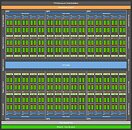Monday, January 20th 2020

Rumor: NVIDIA's Next Generation GeForce RTX 3080 and RTX 3070 "Ampere" Graphics Cards Detailed
NVIDIA's next-generation of graphics cards codenamed Ampere is set to arrive sometime this year, presumably around GTC 2020 which takes place on March 22nd. Before the CEO of NVIDIA, Jensen Huang officially reveals the specifications of these new GPUs, we have the latest round of rumors coming our way. According to VideoCardz, which cites multiple sources, the die configurations of the upcoming GeForce RTX 3070 and RTX 3080 have been detailed. Using the latest 7 nm manufacturing process from Samsung, this generation of NVIDIA GPU offers a big improvement from the previous generation.
For starters the two dies which have appeared have codenames like GA103 and GA104, standing for RTX 3080 and RTX 3070 respectively. Perhaps the biggest surprise is the Streaming Multiprocessor (SM) count. The smaller GA104 die has as much as 48 SMs, resulting in 3072 CUDA cores, while the bigger, oddly named, GA103 die has as much as 60 SMs that result in 3840 CUDA cores in total. These improvements in SM count should result in a notable performance increase across the board. Alongside the increase in SM count, there is also a new memory bus width. The smaller GA104 die that should end up in RTX 3070 uses a 256-bit memory bus allowing for 8/16 GB of GDDR6 memory, while its bigger brother, the GA103, has a 320-bit wide bus that allows the card to be configured with either 10 or 20 GB of GDDR6 memory. In the images below you can check out the alleged diagrams for yourself and see if this looks fake or not, however, it is recommended to take this rumor with a grain of salt.
Source:
VideoCardz
For starters the two dies which have appeared have codenames like GA103 and GA104, standing for RTX 3080 and RTX 3070 respectively. Perhaps the biggest surprise is the Streaming Multiprocessor (SM) count. The smaller GA104 die has as much as 48 SMs, resulting in 3072 CUDA cores, while the bigger, oddly named, GA103 die has as much as 60 SMs that result in 3840 CUDA cores in total. These improvements in SM count should result in a notable performance increase across the board. Alongside the increase in SM count, there is also a new memory bus width. The smaller GA104 die that should end up in RTX 3070 uses a 256-bit memory bus allowing for 8/16 GB of GDDR6 memory, while its bigger brother, the GA103, has a 320-bit wide bus that allows the card to be configured with either 10 or 20 GB of GDDR6 memory. In the images below you can check out the alleged diagrams for yourself and see if this looks fake or not, however, it is recommended to take this rumor with a grain of salt.


173 Comments on Rumor: NVIDIA's Next Generation GeForce RTX 3080 and RTX 3070 "Ampere" Graphics Cards Detailed
@Berfs1 I Can't see any of that panning out, since when did Nvidia improve their best then undercut it? so I think the prices we have now plus 50 dollars minimum, at least at launch with supers or something coming out later ,once stocks of the 2xxx series run out, makes sense tbf.
they are not known for a full lineup on a day, they will introduce their next GPU's slowly and consciously to maximize profits, early birds Will pay, then as yield's improve ,a super or something with a price cut ish sort of.
www.techpowerup.com/review/nvidia-geforce-rtx-2080-founders-edition/
sorry if you don't enjoy high refresh but i do, gpu's have a long way to catch up before i can truly enjoy gaming.
The bottom line is that Ampere will be on the 7nm process node as compared to Turing on the 12nm process node so it should be a good bit more efficient than Turing for the same wattage used so there should be room to add a good bit more cores and faster clocks for the same wattage used.
imo the performance increase with the Ampere will be somewhere between 35% to 50% over Turing
defeatedjebaited by midrange Ampere.But that doesn't mean 3080ti will keep its price point, see my post above.
Nvidia will want to keep its (royal) margin, but most of their price bumps are actually quite understandable within that rationale. Those 'expensive' Turing dies are effin' huge and its only the second gen on 16~12nm.
Next gen, the 3070 should be 2080 Super-like and the 3080 could be at 2080ti levels.
Someone mentioned 16 GB for the 3080ti, but I find that highly doubtful unless it is using HBM2. No way they are running a 512 bit bus on gddr6.
Best guess is 12 gb of GDDR6 at 16gb/s or more.